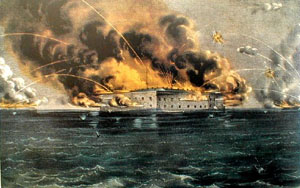Civil War Battles |
Colonial Wars |
American Wars |
Link To This Page — Contact Us —
The Battle of Fort Sumter
April 12-14, 1861 in Fort Sumter, South Carolina
 |
|||||||||||||||||||||
|
On April 12th, Maj. Robert Anderson and 127 men held Fort Sumter in Charleston Harbor, with Capt. Abner Doubleday being second in command. The men had been neither supplied nor reinforced since occupying the fort the night of December 26, 1860. Their presence caused a crisis between the U.S. government and the seceded state of South Carolina, offended at Union troops sitting on sovereign territory. Confederate forces, commanded by Brig. Gen. P.G.T. Beauregard, had thrown up batteries on the harbor's shores north and south of Fort Sumter and trained guns on it from Forts Moultrie and Johnson. Fort Sumter mustered only 66 cannon, several unmounted. At 3:20 A.M., the crisis came to a head.
The Confederate cabinet telegraphed Beauregard on April 10 to fire on Fort Sumter if absolutely necessary to prevent reinforcement. Capt. Stephen D. Lee and Col. James Chestnut, secessionists, rowed out to Fort Sumter and made a last demand for surrender. Anderson refused, but said he would be starved out in a few days anyway.
Beauregard then asked Anderson precisely when he would be forced to evacuate the fort. Anderson carefully considered his reply and said that he would leave by noon, April 15, unless before that time he should receive either instructions from Washington, D.C. or additional supplies. That wasn’t fast enough for the Confederates. At 3:20 A.M. on the 12th, they informed Anderson that their batteries would open fire in one hour. Anderson had also declined previous surrender demands because ships loaded with troops and supplies were reported en route.
After an hour and ten minutes, Capt. George S. James, commanding Fort Johnson's east mortar battery, ordered the firing of a signal shell. At 4:40 A.M., Edmund Ruffin of Virginia, firebrand and hero of the secessionist movement, touched off a gun in the ironclad battery at Cummings Point. 43 Confederate guns in a ring around Fort Sumter began the bombardment that initiated the bloodiest war in American History. Anderson mustered his force on the parade ground, warned the men to not take any unnecessary risks, and sent them to their guns. He offered honor of the Union's first shot to Doubleday, who fired it around 7:00 A.M.
By daybreak, batteries from around Charleston Harbor were assailing Sumter. If Anderson was short of food, he was also short of powder and fuses. Anderson mustered his force on the parade ground, warned the men to not take any unnecessary risks, and sent them to their guns. He offered honor of the Union's first shot to Doubleday, who fired it around 7:00 A.M. It missed, sailing high over the Iron Battery on Cummings Point. A lopsided, 34-hour duel began. After firing a few rounds from different guns, the Federals restricted themselves to serving 6 cannon, since they were short of powder-bag cartridges. Of the 47 guns that had been readied, most never got into the fight. 43 loyal civilian workmen making up part of the garrison sewed more bags from linen, burlap scraps, and socks. The supply ships Anderson expected to arrive in the afternoon of the 12th but were kept outside the harbor by confederate artillery.
Unsurprisingly, the Union bombardment never did much damage. Observing the rules of warfare, Anderson and his men weren’t firing on the city of Charleston, and were fast finding that solid shot didn’t much damage to earthen batteries. The cannonade continued throughout the night. The next morning a hot shot (cannon balls heated in a furnace to start fires) from Fort Moultrie set fire to the officers' quarters. In early afternoon, the flagstaff was shot away. Soldiers braved the shells and fires in the courtyard and retrieved the flag, which they hung out a casemate. About 2:00 P.M., Anderson agreed to a truce, convinced that help was not coming. That evening he surrendered his garrison. Miraculously, no one on either side had been killed during the engagement, and the Federal soldiers, sheltered in Sumter's brick caverns, suffered only five injuries. Sadly, during the 100-gun salute to the US flag – Anderson’s one condition – a pile of cartridges blew up from a spark, killing a soldier.
On Sunday, the 14th, Anderson and his garrison marched out of the fort and boarded ships for transport to New York. They had defended Fort Sumter for 34 hours, until "the quarters were entirely burned, the main gates destroyed by fire, the gorge walls seriously injured, the magazines surrounded by flames."
The Civil War, so long dreaded, had begun.
Books on The Battle of Fort Sumter availible From Amazon.com
